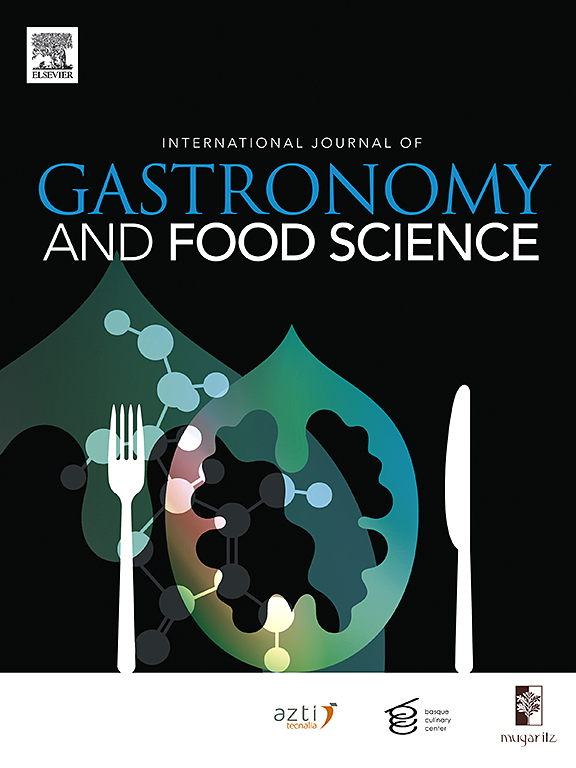基于气相色谱- ims和气相色谱-质谱的油炸鲶鱼主要气味成分表征及加工过程变化研究
IF 3.6
2区 农林科学
Q2 FOOD SCIENCE & TECHNOLOGY
International Journal of Gastronomy and Food Science
Pub Date : 2025-05-23
DOI:10.1016/j.ijgfs.2025.101209
引用次数: 0
摘要
采用气相色谱-质谱(GC-MS)和气相色谱-离子迁移率谱(GC-IMS)技术,结合统计分析,研究鲶鱼制品制备过程中不同操作单元风味特征的变化。结果表明,沟槽鲶鱼在不同加工阶段具有不同的风味特征。其中,1-己醇、乙酸-甲酯和2-甲基丁酸-甲酯是熟化阶段的关键挥发分,辛醇是解冻过程中的关键挥发分。这些化合物可能与8cC20:1的氧化降解有关。戊酮(D)、丙烯、2,3-戊二酮(D, M)、2,3-丁二酮(D)、2-辛酮和苯乙醇是油炸、解冻和再加热过程中的主要挥发物。这些化合物可以由C14:0、C14:1、C16:0、C16:1、C17:0、C18:0、9cC18:1和C18:3n-6的氧化降解产生。丁醛、庚醛、壬醛、2-庚酮(D)、2-己酮、1-辛烯-3-醇和丙烯酸乙酯是整个过程中监测的主要挥发物。这些化合物主要来源于脂质氧化降解。此外,再加热阶段游离氨基酸含量最高,增加了盐度和丰富度。研究样品加工过程中挥发性化合物及其前体物质的变化,为预炒鲶鱼风味调节提供了理论依据。本文章由计算机程序翻译,如有差异,请以英文原文为准。
Characterization of the key odorants in fried channel catfish based on GC-IMS and GC-MS and investigation of the changes during processing
This study aimed to investigate the changes in the flavor profile of different operational units in preparing prepared catfish products using gas chromatography-mass spectrometry (GC-MS) and GC-ion mobility spectrometry (GC-IMS) techniques combined with statistical analysis. The results showed that channel catfish had different flavor characteristics at different processing stages. Among them, 1-hexanol, acetic acid-methyl ester, and 2-methylbutyric acid-methyl ester were the key volatiles in the curing stage, and octanol was the key volatile compound in the thawing process. These compounds may be connected to the oxidative degradation of 8cC20:1. Pentanone (D), propene, 2,3-pentanedione (D, M), 2,3-butanedione (D), 2-octanone, and phenylethanol are key volatiles during frying, thawing, and reheating. These compounds may be produced by oxidative degradation of C14:0, C14:1, C16:0, C16:1, C17:0, C18:0, 9cC18:1, and C18:3n-6. The butanal, heptanal, nonanal, 2-heptanone (D), 2-hexanone, 1-octen-3-ol, and ethyl acrylate were the key volatiles that were monitored throughout the process. These compounds mainly originated from lipid oxidative degradation. In addition, the reheating stage had the highest free amino acid content, which increased the saltiness and richness. Studying the changes in volatile compounds and their precursors during the processing of the samples improves the theoretical basis for the flavor regulation of pre-fried catfish.
求助全文
通过发布文献求助,成功后即可免费获取论文全文。
去求助
来源期刊

International Journal of Gastronomy and Food Science
Social Sciences-Cultural Studies
CiteScore
5.30
自引率
10.50%
发文量
170
审稿时长
45 days
期刊介绍:
International Journal of Gastronomy and Food Science is a peer-reviewed journal that explicitly focuses on the interface of food science and gastronomy. Articles focusing only on food science will not be considered. This journal equally encourages both scientists and chefs to publish original scientific papers, review articles and original culinary works. We seek articles with clear evidence of this interaction. From a scientific perspective, this publication aims to become the home for research from the whole community of food science and gastronomy.
IJGFS explores all aspects related to the growing field of the interaction of gastronomy and food science, in areas such as food chemistry, food technology and culinary techniques, food microbiology, genetics, sensory science, neuroscience, psychology, culinary concepts, culinary trends, and gastronomic experience (all the elements that contribute to the appreciation and enjoyment of the meal. Also relevant is research on science-based educational programs in gastronomy, anthropology, gastronomic history and food sociology. All these areas of knowledge are crucial to gastronomy, as they contribute to a better understanding of this broad term and its practical implications for science and society.
 求助内容:
求助内容: 应助结果提醒方式:
应助结果提醒方式:


